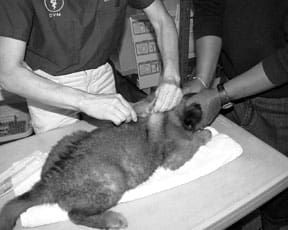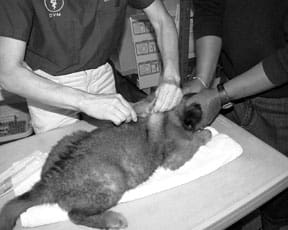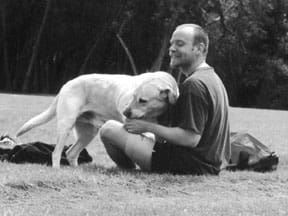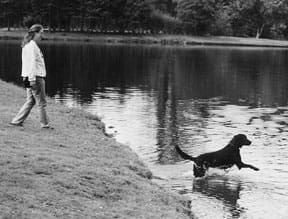[Updated July 5, 2016]
In some dog-related circles, the question of surgical sterilization, otherwise known as spaying (females) and neutering (males), is sure to spark hot debate. Humane associations and shelters are vocal proponents of sterilization for population control, a stand that makes sense considering they’re often the ones who deal firsthand with the tragic consequences of unplanned breeding. But some breeders – an even a few holistic veterinarians – are challenging the need for what they see as knee-jerk spay and neuter policies.
Many breeders, protective of their livelihood, resist any legislative attempts to limit the number of puppies they can legally produce or to mandate sterilization of any dogs. We won’t discuss this position further here.
Our concern today has to do with the assertions of some – voiced publicly by just one veterinarian we know of – that sterilization is wrongly touted as a health and behavior boon for dogs. In fact, the allegation goes, it may even be a threat to their well-being.
We Spay/Neuter for Population Control
Sterilization keeps dogs from breeding indiscriminately. It is de riguer for dogs adopted from shelters to be sterilized before release (or a sizable deposit is taken, refundable when proof of surgery is provided). Humane societies in this country are unanimous in their recommendations for sterilization of companion animals.
According to the Humane Society of the United States, 6 to 8 million dogs and cats enter shelters each year, and at least half of them are euthanized. The organization also calculates that a fertile dog can produce two litters of 6 to 10 pups in a year; that means that the female and her offspring can, theoretically, produce 67,000 unwanted dogs over a span of six years.

By all accounts, widespread sterilization programs have been pivotal to reducing pet overpopulation in the last few decades.
Health Benefits of Sterilization
Many veterinarians and dog experts recommend sterilization for another reason: the health of the dog.
“As far as disease is concerned, it certainly reduces the risks of mammary tumors and ovarian cancer,” says Richard Bowen, DVM, Ph.D, a professor at the Animal Reproduction and Biotechnology Laboratory of Colorado State University. “Anything associated with an active reproductive tract will be eliminated, and that’s a big deal.”
“If you neuter a female dog prior to puberty, she has an almost zero risk of developing breast cancer,” concurs Dr. Olson. Texas A&M’s College of Veterinary Medicine reports that intact female dogs have seven times the risk of developing mammary tumors than do females sterilized early in life.
Male dogs, too, may benefit, with the risk of testicular cancer eliminated – and rates of prostatic cancer reduced.
From a behavioral standpoint, sterilization is widely believed to reduce aggression toward other dogs, territorialism, and roaming, which can in turn protect dogs from the risk of injury associated with those behaviors, such as fights and getting hit by cars. Neutered males, particularly males who were neutered before puberty, are less likely to exhibit inappropriate urine-marking.
Finally, some veterinarians and veterinary behaviorists say that intact, nonbreeding animals suffer stress caused by hormonal drives that are not met.
A Professional Opinion on Spay/Neuter
Myrna Milani, DVM, is the author of seven books on canine and feline health and behavior. The veterinarian, based in Charlestown, New Hampshire, has researched and lectured about spaying and neutering, and doesn’t buy into the “PR campaign,” as she calls it, that responsible owners must sterilize their pets.
“When all of the responsible people neuter their dogs, who’s left breeding?” she asks, answering, “The irresponsible ones.”
Dr. Milani feels it’s unfair that owners are frowned upon if they opt to control breeding by carefully supervising their dogs instead of sterilizing them.
“It is really funny that we’ve equated responsibility with neutering, when in reality you could almost make a case for it being the opposite,” she says. The decision to not sterilize but carefully supervise a dog is “very mature, it takes a tremendous amount of commitment, and it requires a tremendous knowledge of and respect for that dog,” she says.
One reason sterilization is so popular in the United States is that few owners can claim that level of care, says Patty Olson, DVM, Ph.D., a diplomate of the American College of Theriogenologists. She cites Sweden as an example of a society where owner responsibility outweighs sterilization as the preferred choice of birth control.
“In Sweden, 93 percent of dogs are intact,” she says. “They don’t neuter. They have some pretty amazing ordinances by which dogs are controlled, there are very significant fines, and they do seem to have more responsibility. What we’ve had to do in the U.S. was institute something because of, if you will, irresponsibility.”
Sterilization Could Solve Temperament Issues
Beyond the issue of birth control is that of personality. Conventional wisdom has it that sterilized dogs make better pets, are less aggressive, and exhibit fewer behavioral problems.
“Neutering reduces aggression,” says Richard Bowen, DVM, Ph.D, a professor at the Animal Reproduction and Biotechnology Laboratory of Colorado State University. “The earlier you can neuter, the fewer aggression problems you’ll have. Roaming around, urine-marking, sexual behavior toward people and other animals . . . Most of those behaviors are dramatically decreased.”
A study by Sherman et al., published in Applied Animal Behaviour Science (April 1996), found that in cases of non-household aggression where neutering and a head halter were the suggested as remedies, 52 percent of owners reported improvement. An earlier study by Heidenberger and Unshelm, published in 1990 in Tierarztliche Praxis (Feb. 18:69-75), found that behavioral problems in most cases were reduced or eliminated after neutering, with 74 percent of the male dogs showing improvement.
Again, Dr. Milani dissents. Dr. Milani says that most of the dogs she treats for aggression or dominance problems are already sterilized.
“I can count on one hand the intact dogs I’ve seen with behavioral problems in the last 10 years,” she says. “If I have a client who has an (intact) male dog who’s aggressive, I do not recommend they get the dog neutered until after they have a behavior modification program up and running, because otherwise it might make the dog’s behavior worse.”
Dr. Milani says she suspects a “placebo effect” may be occurring: “Somebody has convinced (the owners) that it’s these testicles that are causing the dog’s problem. As soon as they’re out of there, the owner relaxes; and because the owner relaxes, that take the pressure off the dog, so the behavior improves.”
Further, Dr. Milani also believes that sterilization – particularly pediatric sterilization, which is done on very young puppies — may actually cause behavior problems.

“One of the reasons why people are shying away from early neutering of females for behavioral reasons is this condition known as androgenized or masculinized females,” she says. This describes a female pup, born into a predominantly male litter, whose body is awash in testosterone. “So you can actually have a female pup that’s more male than female. If they go through a heat or two, you get that softening effect of the female hormones. Whereas if you neuter them, they’re kind of in a no-man’s land,” she explains.
According to Dr. Milani, these pups have a very difficult time bonding with humans or other dogs and tend to be very aggressive and unpredictable. “I don’t know much in the way of studies…but I think they never make it into the studies because they don’t live that long,” she concludes.
Allegations of Health Risks from Spay/Neuter
Even ardent supporters of sterilization admit that the practice poses health risks. Some of the major concerns include:
• Urinary incontinence. Studies estimate that more than 20 percent of all spayed females will develop incontinence during their lifetimes. Incontinence can develop shortly after surgery or many years later.
• Cardiac tumors. A study by Ware and Hopper (Journal of Veterinary Internal Medicine, March/April 1999) examined over 700,000 dogs’ records between 1982 and 1995 and concluded that neutering appeared to increase the risk of cardiac tumors, especially hemangiosarcoma, in both male and female dogs. According to the study, the relative risk for spayed females was more than four times that for intact females. The risk for castrated males was slightly greater than that for intact males.
• Delay in growth-plate closure. Sterilization, particularly early sterilization, causes the growth plates of the bones to close later. There are fears that this delay can increase the likelihood of fractures.
• Osteosarcoma. In addition to the growth-plate issue, there is growing concern that the lack of sex hormones in a sterilized dog can foster the rise of bone cancer. A 2002 study at the University of Purdue of 683 Rottweilers – a breed known to be at high risk of bone sarcoma – concluded that the risk for bone sarcoma was significantly influenced by the dogs’ ages at sterilization. According to the study, “Exposure to endogenous sex hormones appears to be protective, as suggested by the high risk for bone sarcoma in male and female dogs that undergo gonadectomy within the first year of life.”
The Purdue study quoted data from a 1998 study (Ru G., Terracini B., Glickman L. T.: Host related risk factors for canine osteosarcoma) that found neutered dogs were at 2.2 times greater risk of osteosarcoma than sexually intact dogs.
• Unknow side effects. Dr. Milani also fears that denying the dog the presence of reproductive hormones may have effects that we haven’t yet calculated or considered.
“We know reproductive hormones affect the whole body. If the reason for (an animal’s) physical existence is reproduction, it makes sense that everything evolved to support than function,” she says. Dr. Milani is concerned about cutting off the potential effects those hormones may have on the growing animal, in terms of both physical and brain development.
Not Much Supporting Research
Of the concerns listed above, Dr. Olson and Dr. Bowen acknowledged that increased urinary incontinence is a well-known and well-documented side effect of sterilization in females. But both expressed doubt that the growth-plate issue is a cause for concern.
“That sounds bogus to me,” says Dr. Bowen. “Yes, if you do castration before growth plate closure, it will delay (the closure) so the animals will be slightly larger. But it’s a minor change. For example, one study showed that if a bitch is not spayed, the growth plates close at 42 weeks; if she was spayed at 7 weeks, the closure occurred at 60 weeks.”
“It’s something they determine in millimeters in X-rays – it’s minuscule,” agrees Dr. Olson.
Neither was convinced you could draw a compelling link between the growth-plate closure issue and subsequent problems such as fractures. We were unable to find any veterinarian who was familiar with the data about cardiac tumors and sterilization.
Timing of Sterilization Surgery
Once upon a time, conventional wisdom had it that it was best to allow a female to have one heat before sterilization. However, over the last 10 years there’s been an increasing move to neuter animals at a much younger age – between 6 and 14 weeks – in a procedure called pediatric neutering.
“Out here(on the East Coast, it’s not uncommon for a puppy to show up at a shelter, be taken away from the mother, vaccinated, spayed, and be in a new home by eight weeks of age,” says Dr. Milani. “In terms of animal health, I have concerns about sterilization at any age and these are multiplied a thousandfold when we’re talking about very young animals.”
A number of studies on pups sterilized at two months of age or earlier have showed no serious side effects. However, a study by Spain, Scarlett, and Houpt, published in the February 1, 2004, edition of the Journal of the American Veterinary Association, suggested that pediatric sterilization may have negative effects on females.
“Because early-age gonadectomy appears to offer more benefits than risks for male dogs, animal shelters can safely gonadectomize male dogs at a young age and veterinary practitioners should consider recommending routine gonadectomy for client-owned male dogs before the traditional age of six to eight months,” wrote the authors.
“For female dogs, however, increased urinary incontinence suggests that delaying gonadectomy until at least three months of age may be beneficial.”
What’s Best for Your Dog?
Unfortunately, there’s no easy answer here, and the final decision is a very individual one. The bottom line is that sterilization is a surgical procedure that fundamentally alters your dog’s physiology, and as such carries some risks. However, it’s also an undeniably effective form of birth and population control, and one that enables owners to be more relaxed about their dogs in sexually mixed company.
We’ve spent enough time in shelters to be gravely concerned with the issue of dog overpopulation. However, we also advocate strong owner responsibility and care, and are very sensitive to issues that might compromise the health of our canine companions.
If you choose not to sterilize your companion dog (or choose to delay his or her sterilization until well after puberty), it is imperative that you ensure that he or she is contained in a safe, secure environment and is never – repeat, never – given an opportunity to engage in unwanted breeding. That means keeping females in heat in the house or in a secure kennel during estrus; ensuring that intact males are not physically capable of breaking out of your yard and have no chance of dashing for freedom through an open door; leashing your dogs at all times when outside the home, kennel, or yard; and taking any other precautions necessary to minimize risk. If you cannot guarantee constant vigilance by both you and other family members, you should have your dog surgically sterilized.
If, in contrast, you are concerned about the potential risks outlined above, you may wish to wait until your dog is at least six months old (or, for females, has gone through at least her first estrus) before the surgery. Doing so would give the secondary sexual hormones an opportunity to work their “magic” on the dog’s physiology, potentially protecting the dog (to an as-yet unknown extent) against the development of urinary incontinence, cardiac tumors, osteosarcoma, and other issues concerning the bone growth plates. Of course, you must be hypervigilant against unwanted breeding until the dog is sterilized.
C.C. Holland is a freelance writer in Oakland, California, and regular contributor to WDJ.
























